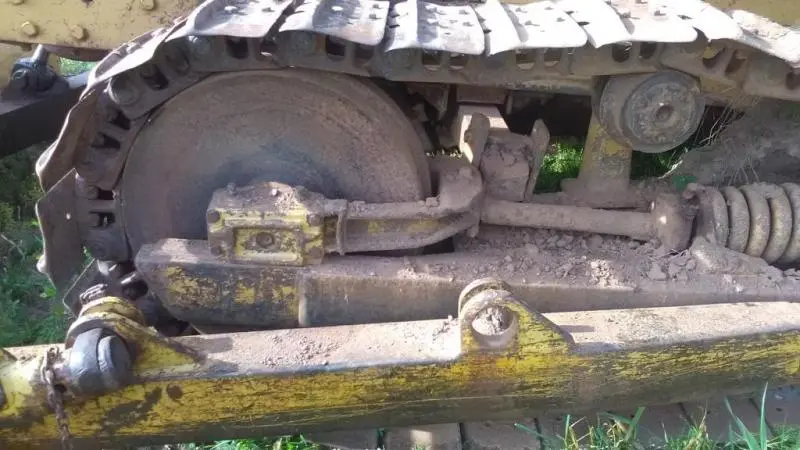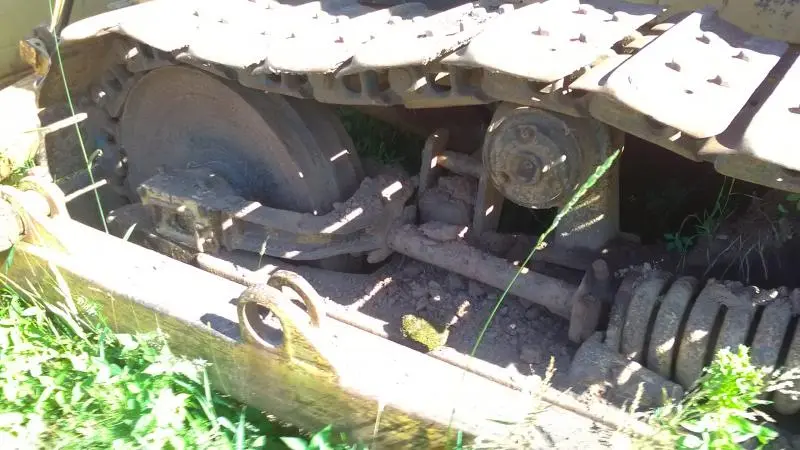

Hi sclan, your first photo shows that the idler yoke was forced back until the yoke dropped down below the wear strip on the roller frame and the idler yoke is now resting directly on the roller frame. The wear strip is now preventing the idler from moving forward.
Caution!! The second photo shows that the recoil spring is now compressed enough that it is no longer touching the recoil spring stop. This is a dangerous situation.
I hope someone will have a better idea, but the only easy fix I know is to make certain everyone is clear and then run the tractor over blocks to force the idler yoke up and over the roller frame wear strip. There should be a loud bang and the idler will be free, hopefully without further damage.
I would then make repairs to the idler yoke/wear strip to reduce the amount of play present so that the “locked back idler” does not occur again.
Hi sclan,
as seiscat is trying to point out is that your idler yoke rod is bent at the rear of the yoke.
This has caused the rear of the yoke to be raised and possibly partly jam on the inner guides inside the track frame channels.
The flange of the adjuster cylinder, and rod, have been forced down by the bent rod and have caught in the track frame recess there--if you clear more dirt away you will be able to see the catch points.
The track adjuster and spring tension needs to be released by opening the adjuster valve a quarter turn to relieve the adjuster pressure.
You may be lucky enough to be able to then lever the adjuster, and recoil spring end of the rod up to disengage it from the track frame--failing that the rod needs to be removed and straightened in a press. It will be bent at the shoulder that the yoke sits against.
The bolts at the yoke split need to be removed completely to slip the yoke off as they sit in retention grooves machined into the reduced diameter area of the rod.
Hope this helps.
Cheers,
Eddie B.
Thanks cat gods :hail:
I figured something like that was going on. Does anyone have a diagram of what that section looks like, the part under the track frame and the wear plate area so I can better get my head around this? The reason is that the tension is relieved from the spring tensioner, all the grease came out and I even removed the entire bolt with the grease fitting so there should be no pressure from that. Would it be back that far that it is bottomed out and pushing the spring back?
It seems there is no vertical play at all, With the tracks off the ground I can take a pry bar and wiggle the other one up and down a bit but this one is solid as a rock. Thanks again guys, I am starting to understand the problem a bit better. Had the old girl for the last 20 years and she is kind of family now, lol
If you stick a large pin. Say 2 1/2 or 3 inch on the sprocket under the track and back the tractor up to compress the spring it will pull the idler back and with ought any weight under the idler you may be lucky enough to get it to slip back where it is supposed to be. A piece of railway line stuck under the sprocket would work.do not break the track until you get the weight off the spring
ok, an update so far.
I drove over a log a bunch of times back and forth to see if that would budge the idler yoke at all and it didn't even budge either horizontally or vertically so its in there like an Alabama tic. there is some space between the lower jaws and the track the yoke slides on (about 1/4" ) I must be missing something but what is stopping the idler yoke from coming up and sitting on the lower slide rails when the weight of the dozer is on the idler?
OK, brace yourself for one of those "wt# were you thinking" moments.
To relive the pressure even more I pumped grease into the adjuster until the spring was compressed about 3/4" off the stops and inserted a plate on either side as a spacer and then relieved the pressure from the adjuster. I think that took a little more pressure off but didn't want to compress it any further using the same process without asking if that was a bright idea or not. :boom:
I think I know the answer on that one, that's a big spring to shoot out a plate at high speeds. I did wrap that area with a welding blanket and a bunch of old thick mud flaps in case one ejected out.
Should I try that again but a bit further to try to relive more pressure?
Ugggghhh..... 😖mash:
Well if it were me I would backoff the adjuster as far as possible. That should take the recoile spring out of the equation. If it doesn't then does the recoil spring have the requisite rods in it to hold it together. I don't know the correct terminology.
Anyway so long as there is pressure on this idler to push it forward is is not going to go and the whole thing seems to be a dangerous situation.
The first of your photos show a wear strip welded on top of the roller frame. Look closely you will see that the idler yoke is resting directly on the roller frame and is trapped behind that wear strip. The second photo shows that this situation has held the idler assy. back far enough to compress the recoil spring enough that the recoil spring does not touch the recoil spring stops. Please take care resolving this problem.
I don't agree with those findings. The wear strip is considerably longer than what is exposed. I don't think it's possible for the bearing block to get behind it. The more common problem is once a link is removed the bearing block is now in a new unused guide location and has bound up along with a bent or raised idler push rod that has it jammed up good. If what has been tried already will not get it free I see no other option than splitting the track, removing the idler push rod so that the idler will unbind itself and even then it may take some torch work on the track frame guide to get it free. Time to service the idler bearing blocks, guides and correct or replace the idler push rod if it is damaged.
Just getting it free will not insure that the same thing won't happen again.
Is it a fact, that the recoil spring is still under compression while the track tension system is completely loosened and the idler push rod is against that compressed spring.
If that truly is the case then splitting the track will not fix that issue. The idler becomes a missile with the track split.
I wonder if the only way around this(if the recoil spring cant in fact be unenergized) is use a torch and heat the spring to relax it and of course destroy it.
Then as OM says you gotta redo the guides.